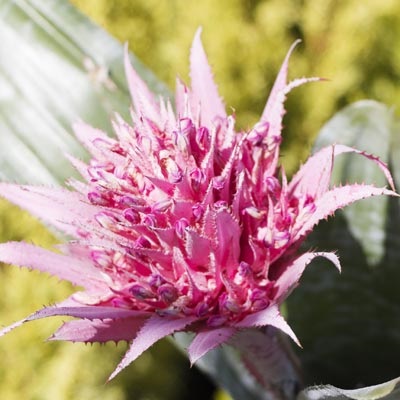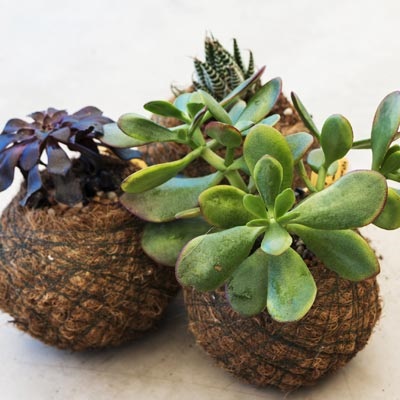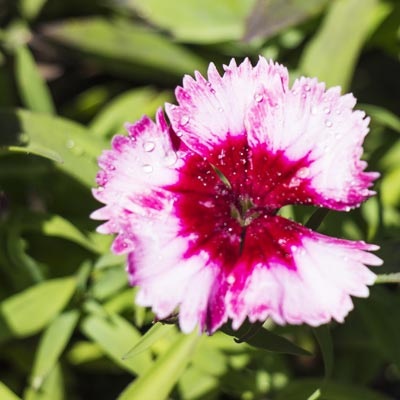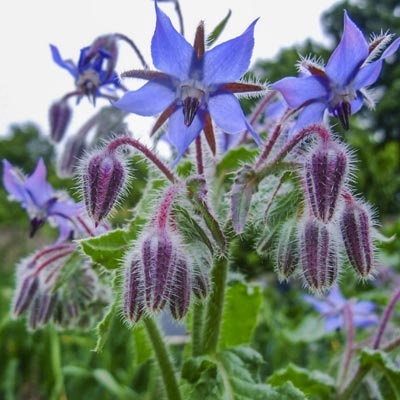When you plant:
- Plant moisture-loving plants on the south and east side of your home, where they’ll receive less sun and plant hardier, indigenous plants on the north and west side
- Always schedule planting of seedlings, shrubs or trees for early in the morning or late in the afternoon. The hot midday sun will make it far more difficult for new plants to cope, which means they’ll need more water.
- Dig troughs or basins around thirsty plants such as roses. This way you won’t lose precious water due to "run-off" when irrigating.
To read more about how to save water visit this website.
HOT Products
Bromeliad Aechmea is a very popular houseplant. Although the plants themselves are beautiful, their long-lasting flowering bracts are stunning.
Usually pink, they rise above the plant like a spiky crown, with smaller purple flowers emerging after time. It's not unusual for an aechmea flower spike to last for months.
This indoor plant grows well in indirect light or moderate shade. When watering, keep water in the central cup. Change water frequently to prevent odours and bacteria from developing.
An optimal indoor temperature for this plant is 13°C or higher. It will grow well in any potting soil mix as it is technically an air plant that uses its roots for support.
Fertilise the plant sparingly with a liquid fertiliser during the growing season.

March in the Garden
Succulent in coir balls. Why not create a talking point with these standing succulent kokedamas? They are available in three sizes (small, medium and large) and contain a variety of succulents.
These succulent coir-covered balls are low maintenance and water wise. They are watered from the top and require minimum watering.
You can place them on a table as a centre piece, arranged in groups on the patio or in the garden. They are ideal for small sunny spots like balconies and decks. They do not require replanting and can be displayed as focal points.

Plant Indigenous
Did you know there are over 100 indigenous species at Stodels Nurseries? In March we focus on planting indigenous plants and how they can make gardening easier.
Why? Because they require less water, they reduce air pollution, provide shelter and food for wildlife, promote biodiversity and stewardship of our natural heritage and save you money!
Chat to your horticulturist about what indigenous plants would best suit your garden.


Broccoli – packed with anti-oxidants
Broccoli is packed with cancer -fighting antioxidants and it’s delicious eaten raw in salads, gently steamed or added to stir-fries and soups. Here’s a step-by-step guide to growing this healthy gem:
- Choose a sunny spot in your garden with well-draining soil. Broccoli will tolerate some shade, but it prefers to grow in the sun
- Dig up the soil and add a generous amount of well-rotted compost
- Your broccoli seeds will start to germinate within 10 days. When the first shoots appear, thin the seedlings out to about 20cm apart
- When the seedlings have about six leaves each feed them with a high nitrogen liquid fertilizer such as Nitrosol
- Broccoli plants are ready to harvest when they are about 10-15cm tall. Use a sharp knife to cut them off their stems. Never tear them off, as this damages the plant
Did you know? Broccoli is a member of the Brassica plant family and therefore needs plenty of nitrogen to fuel the growth of its leaves.
So, getting down to business - what to do in March
Plant and sow:
- Sow all your soup veggies this month: cabbage, cauliflower, carrots, onions, Swiss chard, spinach, celery, leeks, parsnips, turnips and beetroot
- Plant leafy herbs like chives, sorrel, rocket, watercress, basil, dill, parsley, mint and chicory
- Sow or plant flowering seedlings like poppies, stocks, linaria, nemesia, viola, calendula, snapdragons, foxgloves, lupins, dianthus, nasturtiums, asters, larkspurs and pansies
- Sow sweet peas from the last week of March. Sow the seeds just below the surface in well composted soil. For best results, soak the seeds in water overnight before sowing
- Stock up on spring-flowering bulbs so long, but wait until April before planting them
Feed:
- Feed citrus trees with 3:1:5 to encourage fruit development. Water well
- Deadhead roses and feed with a handful of rose food each to encourage another flush of flowers
- Keep azaleas and camellias well watered and mulched. Treat yellow foliage with iron chelate and feed each bush with a tablespoon of Epsom salts
- Stock up on general fertiliser for the whole garden. Wait until the first autumn rains and then give your entire garden a good feed
Prune and divide:
- Prune summer-flowering plants like pelargoniums, lavender, abelia, weigela, daisies, heliotrope and salvia.
- Prune all evergreen trees, except those that bear flowers and berries in spring.
- Divide and replant agapanthus, irises, daylilies and arum lilies.
Planning ahead by reaping what you sow in spring:
- March marks the beginning of the planting season for spring. The weather has cooled down a bit, so it’s time to sow spring- flowering seeds and start thinking about your spring bulbs
- Sow indigenous seeds like blue kingfisher daisies, Namaqualand daisies, bokbaaivygies and African daisies. They all thrive in warm, sunny spots
- Sow sweet pea seeds in full sun. They are available in knee-high (30cm) and climbing varieties (up to 2m). Climbing varieties will need a trellis or climbing support
- Sow fairy primula seeds in shady spots
Herb of the Month - Borage
Borage may be native to the Mediterranean region but is so easy to grow locally. Also known as a starflower, it is a hardy, waterwise herb that grows to a height of 60-100cm.
It is said that borage gladdens the heart with its mass of start shaped, purple flowers. For the avid herb gardener, it’s a must and has a host of culinary uses, but is predominantly cultivated for its high gamma-lineolinic acid (GLA) content. (GLA is recognised as a natural remedy for PMS.)
Use the smaller leaves in a salad (they have a cucumber flavour) or chop them add to soups or sautéed dishes.
Remember that borage tastes like cucumber, so wherever cucumber flavours is needed; borage is likely to be able to act as a substitute.

All images: Supplied
The Last Words ...
"No water, no life. No blue, no green." -Sylvia Earle
Follow Women24 on Twitter and like us on Facebook.




 Publications
Publications
 Partners
Partners










